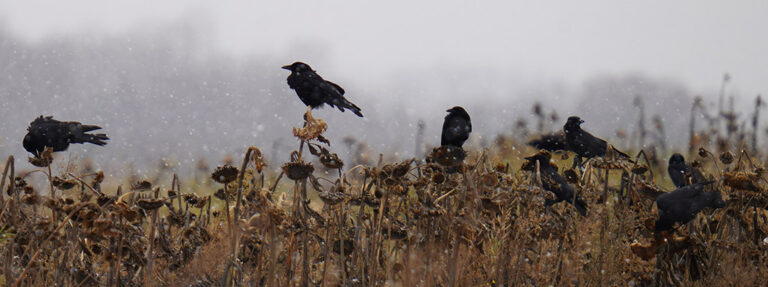Winter presents serious challenges for native birds. As temperatures drop and snow covers the landscape, many of their natural food sources, like seeds, fruits, and insects, become scarce or inaccessible. For species that don’t migrate, the cold season can lead to energy deficits, weight loss, and higher mortality rates.
If you’re interested in helping, this blog is for you. Whether you’re a gardener, farmer, landscape architect, or just someone who loves birds, there are practical steps you can take to support native bird populations through the winter months.
By supplementing their diet with reliable, nutrient-dense food sources, you help increase their chances of survival while supporting the broader ecological benefits birds provide year-round.
This blog will cover:
- Six of the most important winter food sources for native birds
- Which species each source supports
- How and where to offer these foods for the greatest impact
If you want to make a difference for your local bird populations, winter is the time to act.
Understanding the Nutritional Needs of Native Birds in Winter
Winter survival hinges on energy balance. Birds, some of which serve as important pollinators, burn calories rapidly to maintain body heat, often doubling their intake compared to warmer months. With natural food sources limited, the quality and composition of supplemental food become critical.
Key nutritional components include:
- Fat: Primary source of energy for thermoregulation. High-fat foods like suet and sunflower seeds help birds maintain body temperature during extended cold spells.
- Protein: Supports tissue repair, immune function, and feather maintenance. Particularly important for insectivorous species that lose access to their normal prey.
- Carbohydrates: Offer quick-burning fuel but need to be balanced with fat and protein for sustained energy.
- Micronutrients: Seeds and fruits from native plants provide essential vitamins, minerals, and antioxidants not found in processed feeds.
Some bird species also serve as pollinators, particularly when feeding on nectar-rich plants or visiting flowers while foraging. Supporting their survival benefits not just bird populations, but the native plant communities they help sustain.
Understanding these needs helps guide your choices. In colder zones or rural areas, high-fat options may take priority. In milder regions or more urbanized landscapes, a wider nutritional mix can support a broader range of species.
1. Black Oil Sunflower Seeds
Black oil sunflower seeds are among the most efficient and widely accepted foods for overwintering birds. Their thin shells are easy to crack, and the seeds inside are high in fat, which is critical for energy and thermoregulation during cold months.
- Primary species attracted: Northern cardinals (Cardinalis cardinalis), black-capped chickadees (Poecile atricapillus), white-breasted nuthatches (Sitta carolinensis), American goldfinches (Spinus tristis), house finches (Haemorhous mexicanus)
- Best use: Offer in tube feeders with metal ports to discourage squirrels or in covered hopper feeders to keep seeds dry
- Maintenance tip: Clear out wet or moldy seeds regularly. Moisture promotes bacterial growth and deters feeding
Use black oil sunflower seeds as a core food source. Most native birds recognize them immediately. Keep feeders stocked throughout the season for consistent traffic and nutritional support.
2. Winterberry (Ilex verticillata)
Winterberry is a deciduous holly native to the eastern U.S. Its bright red berries persist into winter, offering both visual appeal and critical nourishment to fruit-eating birds.
- Primary species attracted: American robins (Turdus migratorius), cedar waxwings (Bombycilla cedrorum), eastern bluebirds (Sialia sialis), and hermit thrushes (Catharus guttatus)
- Best use: Plant in moist to average well-drained soil in sunny to partly shaded areas; group plantings for visual impact and increased berry production
- Pollination tip: Winterberry is dioecious—plant at least one male (such as ‘Southern Gentleman’) for every 6–10 females to ensure fruit set
Winterberry is one of the most reliable native fruit sources during the early winter. Berries often remain visible above the snow, making them easy targets for foraging birds when other food is buried or exhausted.
3. Gray Dogwood (Cornus racemosa)
Gray dogwood produces clusters of white berries that ripen in late summer and persist into winter, especially in cooler climates where the fruit dehydrates rather than decays.
- Primary species attracted: Northern cardinals (Cardinalis cardinalis), catbirds (Dumetella carolinensis), American goldfinch (Spinus tristis), and Yellow Warblers (Setophaga petechia)
- Best use: Establish along fencerows, woodland edges, or open fields; tolerant of a wide range of soils, including dry or rocky conditions
- Bonus benefit: Dense thickets formed by gray dogwood also offer vital winter cover for small birds
The shrub’s persistence and ecological versatility make it a valuable anchor plant in bird-focused native landscapes. Even if not all berries are eaten right away, the cover alone provides survival advantages.
4. American Cranberry (Viburnum trilobum)
American cranberry offers clusters of bright red berries that hang well into winter, especially in colder regions. The fruit is slightly acidic, which makes it less prone to early decay and a more dependable resource later in the season.
- Primary species attracted: Eastern bluebirds (Sialia sialis), cedar waxwings (Bombycilla cedrorum), and grouse species in rural areas
- Best use: Plant in full sun to partial shade; prefers loamy or well-drained soils but tolerates periodic wetness
- Ecological note: Also supports pollinators in spring with its flat-topped clusters of white flowers
Birds will often eat these fruits once softer, higher-sugar options have been exhausted, making cranberrybush an excellent “late-winter” fallback. Its dual value for both wildlife and ornamental landscapes adds to its appeal.
5. Spicebush (Lindera benzoin)
Spicebush produces red drupes that ripen in late summer and persist into early winter, making it a transitional food source as birds shift from autumn abundance to winter scarcity.
- Primary species attracted: American robins, thrushes, and wood thrushes (Hylocichla mustelina), especially in wooded environments
- Best use: Prefers moist, rich soils and dappled shade; ideal for understory plantings in deciduous forests or riparian corridors
- Additional benefits: Also hosts the spicebush swallowtail butterfly (Papilio troilus)
While the fruits don’t last deep into winter like winterberry, they offer an important nutritional bridge during early freezes and snowfall. Birds often cache or revisit these berries as other food disappears.
6. Sumac (Rhus spp.)
Sumac is one of the most dependable winter food sources in open or disturbed habitats. Species like staghorn (R. typhina) and smooth sumac (R. glabra) hold their crimson seed clusters through winter, even under snow and ice.
- Primary species attracted: Flickers (Colaptes auratus), robins, sparrows, and over-wintering bluebirds
- Best use: Plant in sunny, well-drained sites; sumac spreads via rhizomes, forming colonies that stabilize soil and expand habitat
- Maintenance tip: Allow natural regeneration. Sumac is a pioneer species and thrives without much intervention
Though often overlooked, sumac’s persistence through freezing weather makes it one of the last-standing food sources in the native landscape. Its value peaks in late winter when other fruits have long since disappeared.
Supporting Native Birds Through Smarter Winter Feeding
Winter is a critical time for native birds, and the right food sources—especially those provided by native plants—can make a measurable difference in their survival. By incorporating these six regionally appropriate options into your landscape, you can offer reliable winter forage while supporting the ecological relationships that sustain bird populations year-round.
To go a step further, choose seeds and plants from sustainable suppliers who prioritize native ecosystems. Ernst Conservation Seeds offers regionally adapted, high-quality products that benefit both wildlife and the environment.
If you’re unsure what to plant or provide this winter, reach out. The experts at Ernst can help you select the right seed mixes and habitat solutions for native birds in your area.

